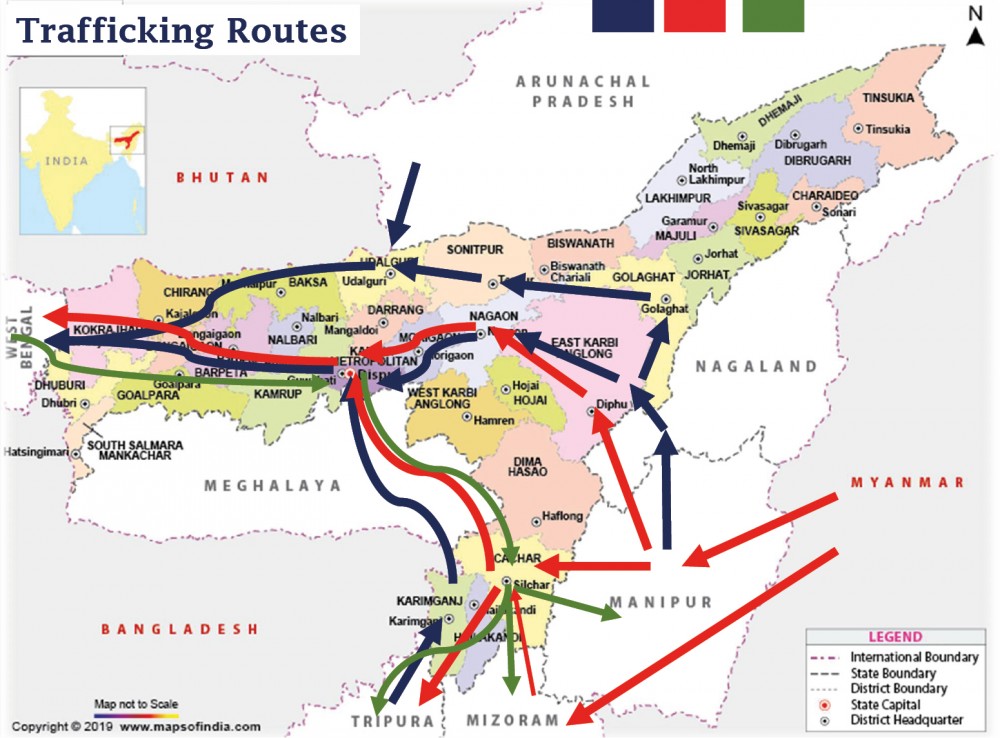Map of Northeast India showing the transit routes from where drugs get trafficked to the other parts of the country and abroad. (Photo Courtesy: Lunkholal Palal Guite, Intelligence Officer, NCB, Zonal, Guwahati)

International Day against Drug Abuse & Illicit Trafficking observed in Dimapur
Morung Express News
Dimapur | June 27
Revealing that Nagaland figures among the 10 states in India whose percentage of population are severely affected by drug abuse, Lunkholal Palal Guite, Intelligence Officer of Narcotics Control Bureau (NCB), Zonal, Guwahati divulged that the state had a high prevalence of sedative users, including injecting drugs and opioid use.
The official was speaking at the International Day against Drug Abuse & Illicit Trafficking observation held at the Excise Conference Hall on June 27. He gave a presentation on ‘Emerging scenarios & challenges in the combat against drug trafficking in the NE region: An enforcement’s perspective.’
He mentioned that other NE states like Manipur, Mizoram, Arunachal Pradesh and Sikkim also featured in the top ten list of states for drug abuse, besides Nagaland.
He added that this complex drug problem was due to the country and particularly the NE region’s close proximity to the two largest illicit drug producing regions in the world—the ‘Golden Crescent’ located in the west and ‘the Golden Triangle’ in the east of India. “These two regions account for more than 90% of the world’s main opium/heroin production,” the data revealed.
The ‘Golden Crescent,’ comprises of Pakistan, Afghanistan and Iran, while the ‘Golden Triangle’ consists of Myanmar, Thailand and Laos.
On top of this, he said that India is the largest manufacturer and exporter of precursors chemicals like Ephedrine, Pseudoephedrine, Acetic Anhydride and Potassium Permanganate which are used in manufacture of narcotics and psychotropic substances. “NE India is thus sandwiched between a precursor chemical supplying country and the drug producing Golden triangle.”
Moreover, chemicals/precursors are smuggled from mainland India to the NE and then onwards to Myanmar. These chemicals are used for processing morphine, heroin and meth, which are then pushed back into the NE and then to other parts of India. He noted that Moreh, Champai and Guwahati are the nucleus of the drug trafficking industry in the region.
The officer also remarked how the modus operandi of trafficking in the NE region is done through smuggling drugs in specially designed cavities in transport vehicles, carry bags, trains, two wheelers, buses and light vehicles.
Over the years, the police have intercepted several of these consignments. However, as the demand for local consumption exists; these operations continue to go on unabated.
Nagaland: A transit route
Guite stated that Nagaland serves as a transit route for trafficking drugs from Manipur and Myanmar such as morphine, opium and brown sugar/heroin with Dimapur as the main transit hub.
Guite said that as per the Ministry of Social Justice and Empowerment’s report on the ‘Magnitude of Substance Use in India 2019;’ in Nagaland, 4.7% and 6.5% of the surveyed population were users of cannabis and opioids respectively.
Drugs such as cannabis/ganja, methamphetamine, heroin and opium/morphine from Manipur are also being trafficked via Moreh-Imphal-Kohima-Dimapur route and then to other states using rail route.
Challenges and obstacles
Guite noted how the lack of proper fencing at the border between India and Myanmar allows free smuggling of drugs. In this, he mentioned the Free Movement Regime (FMR) between the two countries allowing free movement of Indians and Burmese within 16 km of the border without visa restrictions.
Other challenges included the use of drones/Unmanned Aerial Vehicles (UAVs), Darknet and use of unregistered sim-cards.
Guite further stated that the possibilities of involvement of armed groups in illicit cultivation of opium and cannabis in affected districts of the NE cannot be ruled out. He said that there are clandestine labs for preparation of heroin and methamphetamine tablets in Manipur and Myanmar bordering with India.
He viewed that the lack of coordination and intelligence sharing among different central and state enforcement agencies have drastically led to the failure in curbing drug trafficking.
Measures to adopt
Guite shared that dismantling trafficking networks within the region requires ramping up capacities and capabilities of the Drug Law Enforcement Agencies (DLEAs); and improved and effective coordination between agencies of the centre, state and trans-national governments in the region.
He asserted that the centre has directed all states to form dedicated Anti Narcotics Task Forces (ANTF) under DGPs which will work as State NCORD Secretariats. “Instructions were also given to develop Narco-canine pool at the national level, NCB in coordination with NSG, directed to make a policy under which the facility of canine squad be provided to state Police as well,” he said.
Revamping of investigation skills, strong political support, identification, eradication of illicit cultivation and digitization of drug seizure data were among the other measures that the Centre was mulling over.
During the programme, Kevekha Kevin Zehol, NCS, Secretary, Department of Excise & Prohibition also spoke on the challenges faced by law-enforcement agencies which included lack of financial resources and funding from the Centre.
He commented on how there needs to be joint efforts and coordination meetings between different agencies of the states.
Aside from these, Zehol admitted that the government needs to pull up its socks. He meanwhile encouraged NGOs and churches to also do their parts in sensitising and helping people with drug addiction.






